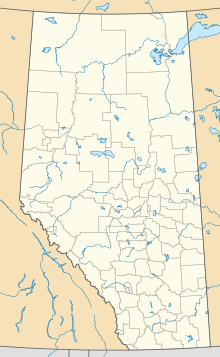Zama City
Zama City | |
|---|---|
Hamlet | |
 Location of Zama City in Alberta | |
| Coordinates: 59°09′06″N 118°42′21″W / 59.15176°N 118.70590°WCoordinates: 59°09′06″N 118°42′21″W / 59.15176°N 118.70590°W | |
| Country | Canada |
| Province | Alberta |
| Census division | No. 17 |
| Specialized municipality | Mackenzie County |
| Government | |
| • Type | Unincorporated |
| • Reeve | Peter F. Braun |
| • Governing body | Mackenzie County Council
|
| Area | |
| • Land | 21.68 km2 (8.37 sq mi) |
| Elevation | 320 m (1,050 ft) |
| Population (2016)[1] | |
| • Total | 74 |
| Time zone | UTC−7 (MST) |
| • Summer (DST) | UTC−6 (MDT) |
Zama City is a hamlet in northwestern Alberta, Canada within Mackenzie County.[2]
It is located north of Zama Lake along Zama Road, which branches off the Mackenzie Highway (Highway 35) approximately 80 kilometres (50 mi) north of High Level.
The hamlet is located in Census Division No. 17 and in the federal riding of Grande Prairie—Mackenzie.
Demographics[]
As a designated place in the 2016 Census of Population conducted by Statistics Canada, Zama City recorded a population of 74 living in 34 of its 61 total private dwellings, a change of -20.4% from its 2011 population of 93. With a land area of 21.68 km2 (8.37 sq mi), it had a population density of 3.4/km2 (8.8/sq mi) in 2016.[1]
As a designated place in the 2011 Census, Zama City had a population of 93 living in 36 of its 74 total dwellings, a −58.7% change from its 2006 population of 225. With a land area of 19.34 km2 (7.47 sq mi), it had a population density of 4.809/km2 (12.45/sq mi) in 2011.[3]
Economy[]
It is based mainly around the oil and gas industry. A major oil pipeline connects Zama City with Norman Wells in the Northwest Territories.
Transportation[]
Two airstrips serve the community, Zama Airport (CEX5) and Zama Lake Airport (CFT9).
See also[]
References[]
- ^ a b c "Population and dwelling counts, for Canada, provinces and territories, and designated places, 2016 and 2011 censuses – 100% data (Alberta)". Statistics Canada. February 8, 2017. Retrieved February 13, 2017.
- ^ "Specialized and Rural Municipalities and Their Communities" (PDF). Alberta Municipal Affairs. January 6, 2021. Retrieved September 29, 2021.
- ^ "Population and dwelling counts, for Canada, provinces and territories, and designated places, 2011 and 2006 censuses (Alberta)". Statistics Canada. 2012-02-08. Retrieved 2012-04-07.
External links[]
- Hamlets in Alberta
- Designated places in Alberta
- Mackenzie County
